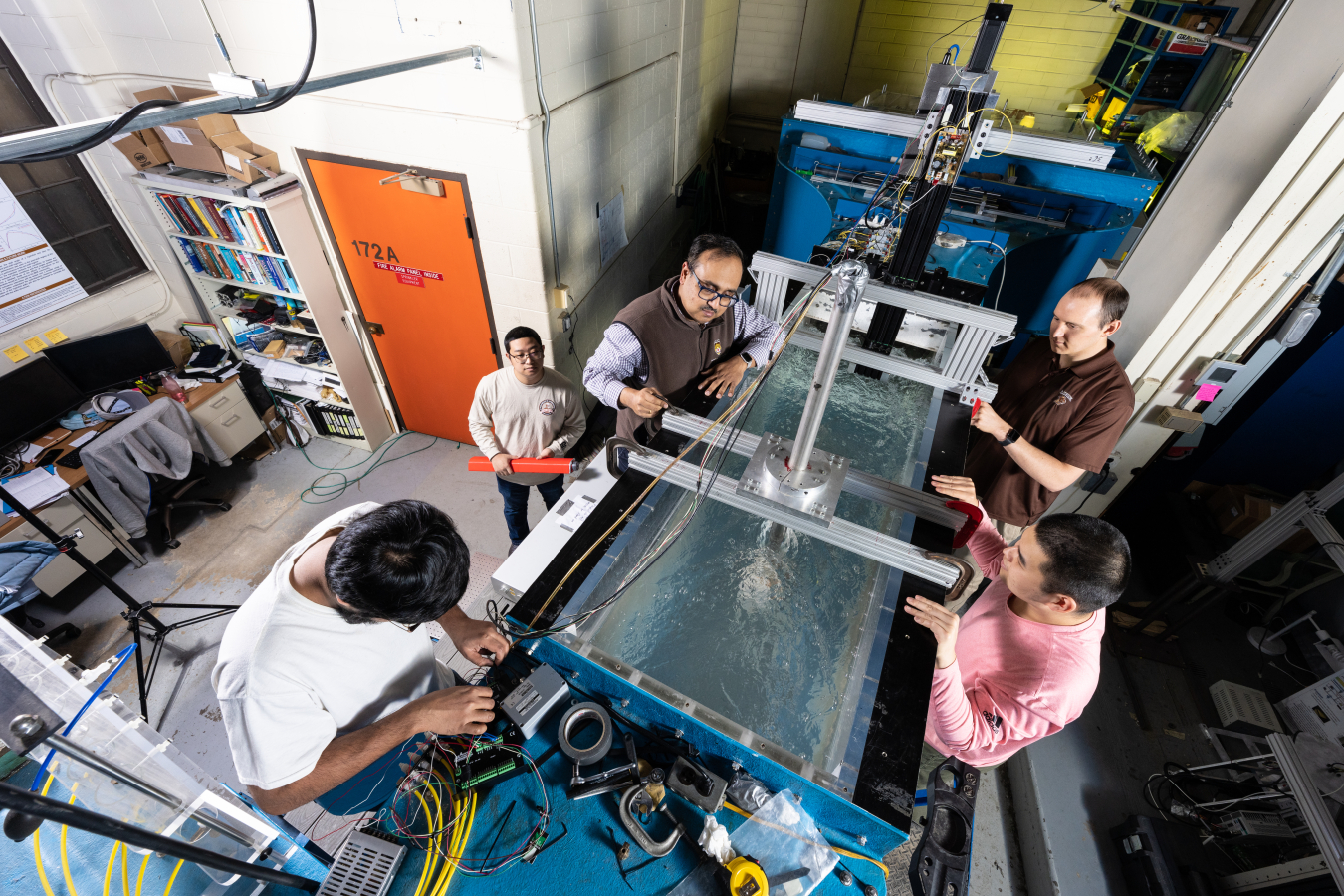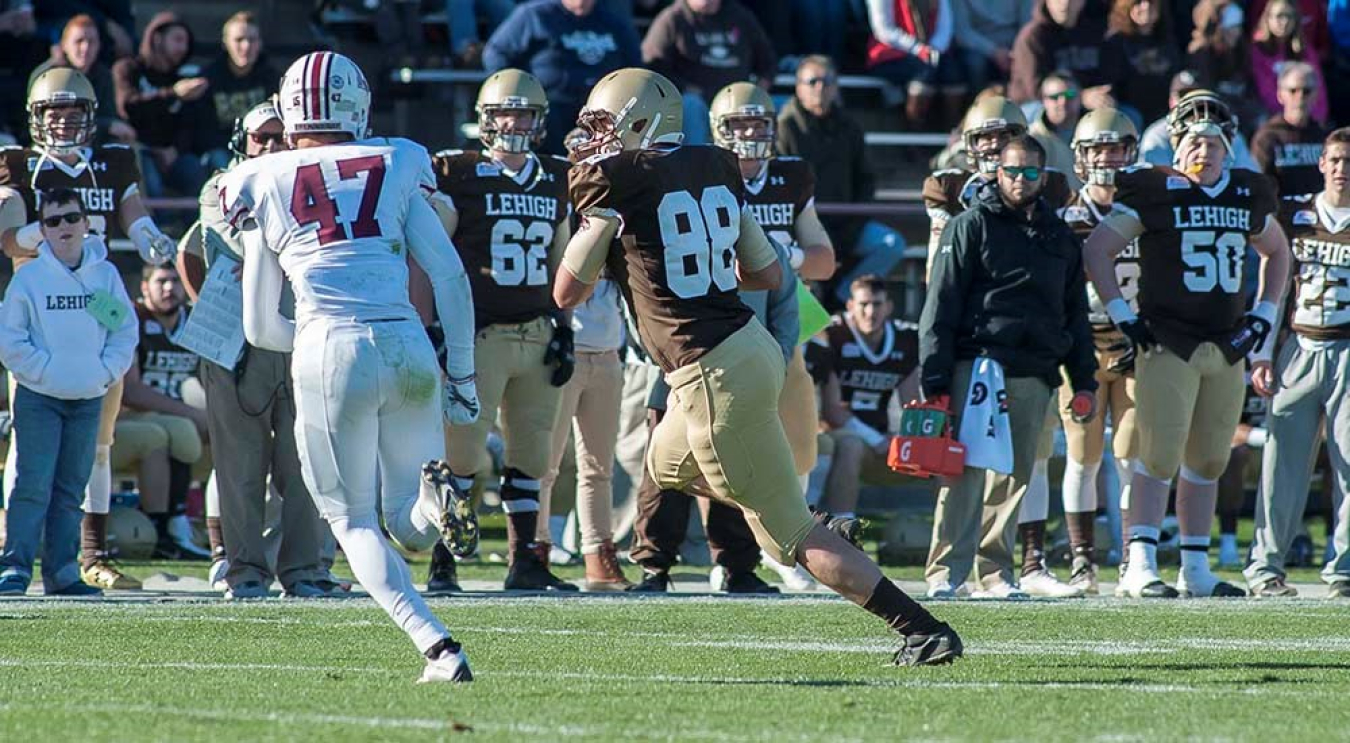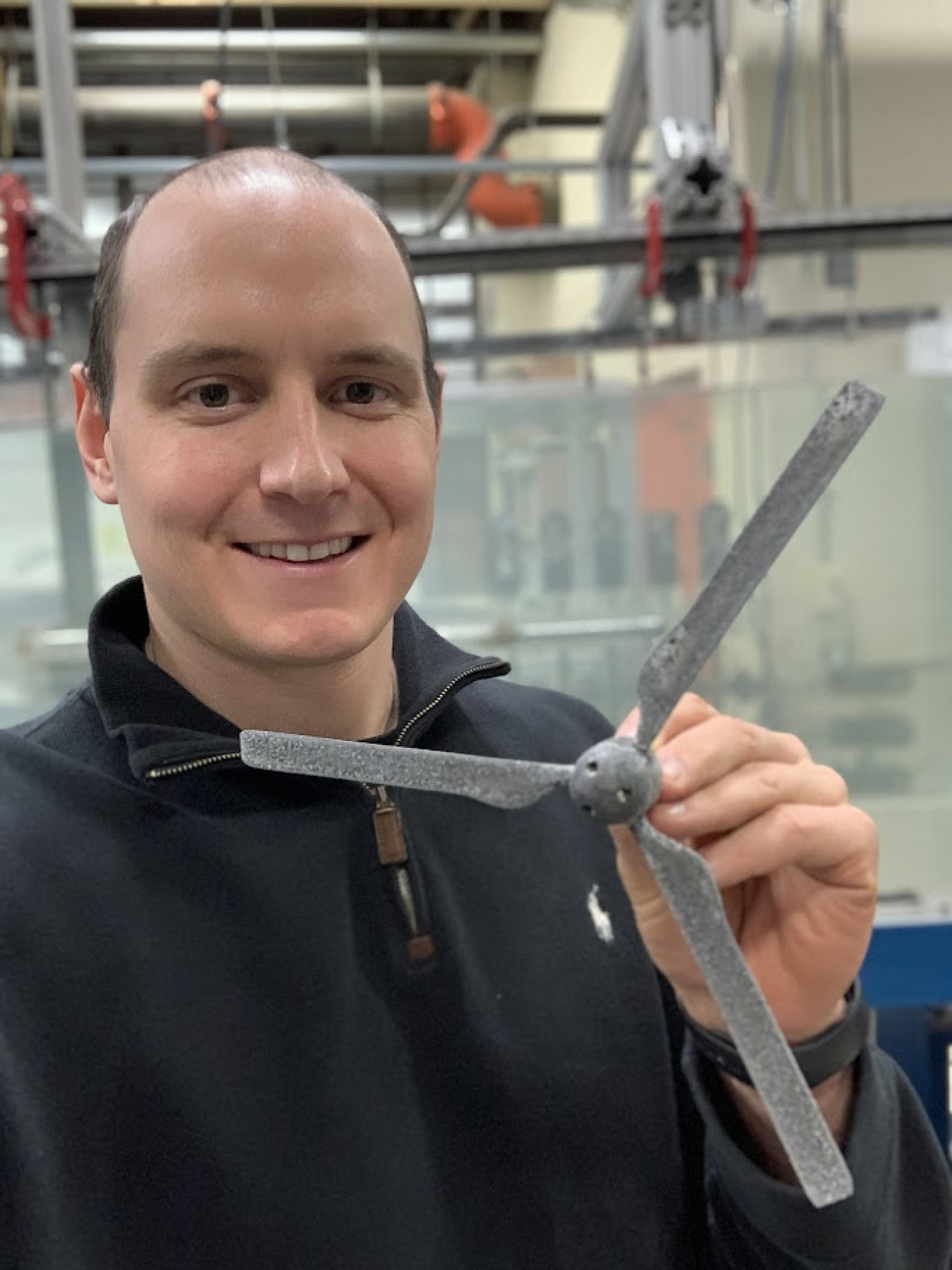It was summer football training that brought Christopher Ruhl to mechanical engineering. Now a Ph.D. candidate and fellow in the Marine Energy Graduate Student Research Program, he uses those skills to study turbulence and and how it affects tidal energy.
Water Power Technologies Office
November 15, 2022Christopher Ruhl was a big fan of building blocks and tinkering toys—the childhood playthings of many future engineers—but, he said, it was football, and not childhood tinkering, that brought him to mechanical engineering.
Today, Ruhl, a Ph.D. candidate in mechanical engineering at Lehigh University in Pennsylvania, has earned one of three 2022 fellowships for the Marine Energy Graduate Student Research Program funded by the U.S. Department of Energy’s Water Power Technologies Office.

Christopher Ruhl (right, back) earned one of three prestigious marine energy fellowships for graduate students. During the program, Ruhl will help advance tidal energy technologies.
Ripple Effect
WPTO’s Ripple Effect series features individuals whose impactful work will help advance hydropower and marine energy technologies to achieve a clean energy future.
But Ruhl might never have applied if not for his love of playing football. As an undergraduate student, he was exploring one field of engineering after another, unsure which to pick. Then, after sophomore year, Ruhl was searching for an excuse to stay on campus over the summer to train harder for his fall football season when his coach introduced him to the chair of the Mechanical Engineering Department. The chair happened to be a big football fan, too.
“Next thing you know, I spend the entire summer working in his research lab studying three-dimensional metal printing,” said Ruhl. “That was the first experience I had with true engineering research at the college level, and I fell in love with it.”
Now, for his graduate studies, Ruhl is using his engineering prowess to study turbulence and how it affects the budding field of tidal energy. For his fellowship, he’ll work with Sandia National Laboratories to understand how turbulence might impact tidal energy devices at potential sites around the world. This work, which is part of Ruhl’s graduate thesis, could help help developers design technologies that endure in even highly turbulent waters.
“For me, football and engineering ran parallel to each other, so the same hard work and effort that I put on the field is what I put in the classroom and now in the lab as well,” he said.
Ruhl shared about his zigzag path to engineering, the biggest myths he hears about renewable energy, and what excites him most about the great promise of tidal energy.

If not for Ruhl’s dedication to his Lehigh football team, he may never have fallen for engineering research. Now, he’s engineering the marine energy technologies that can help power the country’s clean energy future.
Did you ever consider becoming a professional football player?
You have to be pretty exceptional to move on to the next level. I realized that wasn’t in the cards for me. So, while I did put all the effort I could into my four years playing football, I was also setting myself up for a career in engineering at the same time.
We already know how you ended up studying engineering as an undergraduate student. What made you decide to pursue a Ph.D.?
Like a lot of college graduates, I wasn’t sure what I wanted to do. I took some zigzags. I did the whole New York City life in my mid-20s, and I had some cool experiences outside of engineering. But being away from engineering is what solidified that I wanted to go back.
But you didn’t go straight to a graduate program?
I took a role as a civilian mechanical engineer for the U.S. Army. I expected that to be my long-term career. I saw some really interesting work from afar, but I realized everyone working on those projects had doctoral degrees. So, I applied to the Ph.D. program at Lehigh and was accepted. In 2019, I joined Professor Arindam Banerjee’s lab. He works in the general field of renewable energy and, more specifically, studies turbulence and how it affects renewable energy forms.
What excites you most about your current research?
Every single day, when I walk into my lab, I’m working on things that have never been worked on before or discovering things that haven’t been discovered before. At Lehigh, we have one of the first and only tidal turbulence test facilities in the world that is equipped with an active grid turbulence generator. This active grid allows us to produce desired levels of turbulence in our water tunnel. It’s one of a kind. And it’s really exciting coming across problems that no one has stumbled on before.
Ruhl sees tidal energy technologies, like the tidal turbine prototypes he works on for his graduate research at Lehigh University, as a key part of tomorrow’s diverse renewable energy team.
Why apply for this fellowship? What does it allow you to accomplish that you may not have otherwise?
The earlier years of my Ph.D. were spent working inside the walls of academia. Now, in partnering with Vincent Neary at Sandia National Laboratories, I’ll get to see what’s outside those walls and gain more of a practical understanding of how the topics I’m studying at the lab scale can affect full-scale studies and deployments of tidal energy devices.
Did you face any career obstacles up to this point?
Most of my obstacles have been self-imposed. I wondered, “Is it too late to go back to school? Or too risky to jump out of engineering? And then a year and a half later, return to engineering?” It was just a matter of overcoming these obstacles myself because I’m the one who set them in the first place.
What excites you most about the future of tidal energy?
What excites me about tidal energy is just how much room there is to grow and advance this technology. If I walk down the street and bump into 10 strangers, quite a few of them probably don’t know what tidal energy is. They probably don’t know there were three tidal energy turbines in New York City’s East River that were powering a grocery store on Roosevelt Island. One of my passions is teaching, so realizing that I can be someone to help educate the general public, my family, and my friends about what tidal energy is… that’s really exciting and motivating every day I come into the lab.
What myths or misconceptions do you often hear about renewable energy?
The biggest myth or misconception is that one type is better than another. When people think of the different renewable energy technologies, they immediately start comparing them. That’s fine; it’s part of the science and part of advancing our studies. But I don’t think we should be using the success or the improvement of one particular form of renewable energy to knock a different form. For example, just because one form of renewable energy might be more effective or have a lower cost of energy, that doesn’t mean we don’t need the others. If anything, that should be motivation to put more research into the areas we can grow. The ultimate solution is not one particular technology; it’s going to be a consortium of all forms of renewable energy.
So, in an ideal world, what would you hope to accomplish in renewable energy?
Whatever I do, I want to be able to look back on my career and see that I’ve made a tangible impact, whether that’s in the development of tidal energy technologies, other renewable energy technologies, or human capital (educating other people).
What do you hope to gain from your fellowship?
I’ve set two primary goals for my time working with Sandia National Laboratories. The first is to get an authentic taste of what it is like working at a national lab. The second is to better connect the experimental work I’ve done at the lab scale with full-scale, real-world endeavors. I hope my fellowship will help me connect the dots of my research to the bigger picture—the broader impact my studies could have within the marine energy community.

"I want to be able to look back on my career and see that I’ve made a tangible impact, whether that’s in the development of tidal energy technologies, other renewable energy technologies," said Ruhl, a marine energy fellow.
What advice do you have for someone thinking about applying to the Marine Energy Graduate Student Research Program?
Apply! Becoming a better researcher sometimes requires stepping outside of the everyday routine in your university’s lab. So, take advantage of opportunities that will broaden the scope of your research or give you an entirely new perspective on your studies. This fellowship has given me that opportunity, and I hope it will make me a better researcher, a better graduate student, and a better future employee. Also, do your homework to find a host facility that will fit well with your studies, and make sure it is somewhere that excites you! This is a unique opportunity to test the waters at a company or national lab that you may not have access to until after graduation.
What advice do you have for other folks who want to pursue a career in tidal energy or renewable energy more broadly?
My advice is to get outside the walls of academia. It’s important to have that foundation and then apply it in real-world experiences, too. For me, that was in New York City with Verdant Power, deploying the tidal turbines in the East River. I distinctly remember a 2019 visit to the site where these turbines were deployed. For the first time, I realized how what I was studying in the lab connects to the general population. Regardless of what field you’re in, it’s important to keep the big picture in mind. And sometimes, that means stepping out of your comfort zone and looking for opportunities where you can see that big picture, like I did with Verdant Power, and hopefully, what I’ll be doing with Sandia National Laboratories during my fellowship, too.
Are there any other tidal energy developments you’re especially excited about?
Yes, the Atlantic Marine Energy Center! It’s a newly formed consortium with Lehigh University, the University of New Hampshire, Stony Brook University, and the Coastal Studies Institute of North Carolina that helps advance the marine energy industry through multi- and interdisciplinary research and marine energy device and component testing, and by fostering connections and sharing knowledge and experience through education. My advisor, Professor Banerjee, has been critical in launching that center. It’s a really exciting time. There have been similar successful endeavors in the Pacific Northwest and now, with this center on the East Coast, I'm really excited to see how far we can advance these technologies.
The Marine Energy Graduate Student Research Program is open to full-time graduate (master’s and doctoral) students with a marine energy-focused research thesis and/or dissertation at a U.S. institution. Applications for the 2023 program are due Dec. 2, 2022.
Catch up on WPTO's other Ripple Effect profiles and Office of Energy Efficiency and Renewable Energy Clean Energy Champions. And stay in the know with WPTO! Receive the latest information on funding opportunities, events, and other news by subscribing to the Hydro Headlines and Water Column newsletters, as well as the comprehensive Water Wire newsletter.

